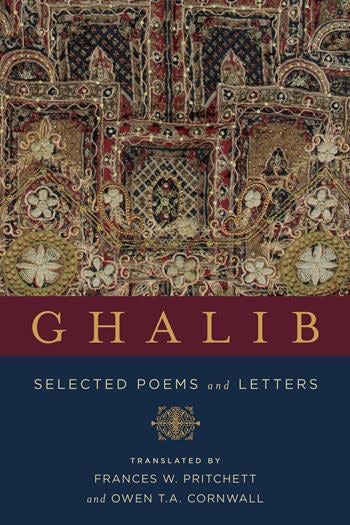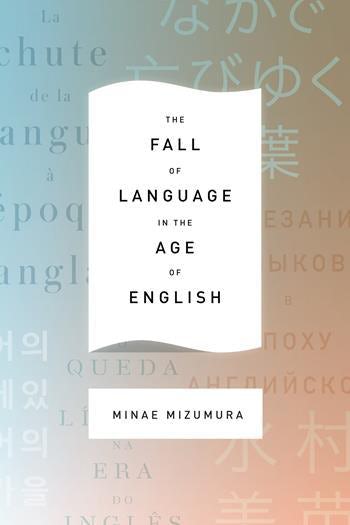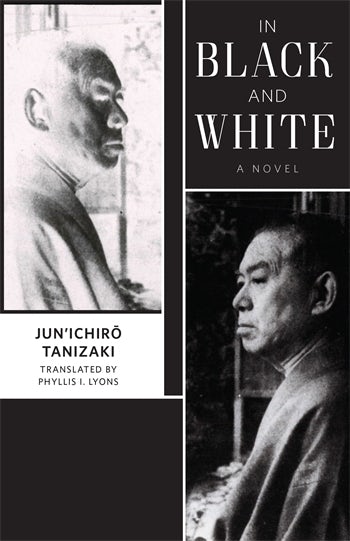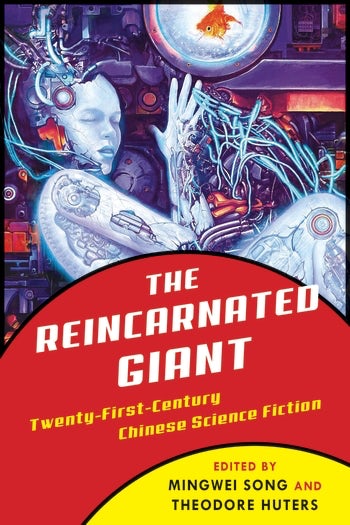Book Excerpt! Ghalib: Selected Poems and Letters

September is National Translation Month. We have been sharing excerpts and guest posts throughout the month but have devoted Saturdays to featuring poetry titles in translation. Today we will be featuring selections from Ghalib: Selected Poems and Letters, translated by Frances W. Pritchett and Owen T. A. Cornwall. Ghalib was a prominent poet from the Mughal Empire writing in Persian and Urdu. Today’s post includes an excerpt from Pritchett and Cornwall’s introduction to the book and two of their translations of Ghalib’s ghazals.
• • • • • •
From “Ghalib and the Urdu Ghazal”
The Urdu ghazal—Ghalib’s favorite genre, and the crown jewel of Indo-Muslim poetry—consists of a number of independent two-line verses unified only by rhyming elements and meter; these verses are most often recited independently, and each must make its own poetic impact. Since each verse is only fifteen or twenty words long, every word must count, and as many words as possible must count in more than one way. Thus ghazal verses need a strong support network of shared prior knowledge and stylized tropes.
Newcomers to the ghazal world often ask why, if each two-line verse is so independent, the whole ghazal exists at all. Ultimately, from the poet’s point of view the ghazal provides the sort of framework that, say, a velvetlined case provides for a matched set of jewelry. The necklaces, earrings, brooches, bracelets, rings in the set may be brought out selectively and in any order, but they are guaranteed to resonate well together, and subsets of them will always enhance one another in various ways. (From the listener’s point of view, the ghazal is like a box of chocolates that are outwardly identical; only as you bite down on each one do you discover whether its heart is creamy, nutty, or full of some liqueur.)
“Newcomers to the ghazal world often ask why, if each two-line verse is so independent, the whole ghazal exists at all. Ultimately, from the poet’s point of view the ghazal provides the sort of framework that, say, a velvetlined case provides for a matched set of jewelry.”
The jewel case itself is made of meter and rhyme. The meter is imported directly from Arabic and Persian and is precisely defined and scrupulously adhered to: in most meters, every single line in the ghazal must contain precisely the same prescribed sequence of long and short syllables. The rhyme consists of at least one rhyming syllable (qāfīya) at the end of each two-line verse, normally followed by a brief refrain (radīf). These two-line verses are technically not couplets, since they do not rhyme.
The first verse of a ghazal commonly incorporates the rhyme and refrain at the end of both lines, instead of only at the end of the second line. Such a first verse is called an opening-verse (matla‘). Under the performance conditions of a mushā‘ira, this feature enables listeners to perceive the formal structure of the ghazal more quickly: they can at once tell how much will be rhyme and how much will be refrain. The last verse commonly includes the poet’s chosen pen name, and such a verse is called a closing-verse (maqta‘). Both these features of course reflect the ghazal’s strong expectation of oral performance.
A mushā‘ira, the traditional venue for oral performance, usually consisted of a smallish group of (almost always male) patrons, connoisseurs, master poets, and apprentices. Most mushā‘iras were based on a well-known “pattern” line announced in advance, so that everybody’s ghazals composed in this pattern were formally identical (sharing meter, rhyme, and refrain). This formal identity made them extremely comparable, and individual achievement stood out strikingly. Recitation of the first line of a verse was followed by a longish pause full of praise and exclamatory comment from the audience, after which the first line was repeated and then at last followed by the second line. Mushā‘iras were thus lively and participatory. This style of oral presentation created an interval during which the audience had access to the first line but not the second—with possibilities for creating suspense, misdirection, and surprise that became major factors, along with complex wordplay, in the development of the ghazal’s poetics.
“At the most basic thematic level, the ghazal is the first-person voice of a passionate male lover who laments his lack of access to his beloved.”
At the most basic thematic level, the ghazal is the first-person voice of a passionate male lover who laments his lack of access to his beloved. In some verses the beloved is clearly feminine (as for example when women’s clothing or veiling is mentioned); she is then either a courtesan or an inaccessible lady in purdah. In other verses the beloved is clearly masculine (as when the beginnings of the coquettish adolescent boy’s beard are said to appear, destroying his androgynous charm; think of Plato’s Symposium). In most verses, the gender of the beloved is not revealed. This undecideability is due partly to the brevity of the verses and to the emphasis on the lover’s own perspective and feelings. The beloved is in any case always treated as grammatically masculine, perhaps because only masculine pronouns are considered to be appropriate for God—since in the ghazal world, the ultimate beloved is God. In the present volume, we generally refer to the beloved with feminine pronouns. This practice is mostly for clarity: since the lover is always masculine, having a feminine beloved as the default makes it easier to show, in translation, who did what to whom.
Even if the beloved is human, he or she is a kind of divinely powerful and inaccessible being, one whose beauty is fatal. The lover knows from the beginning that he is doomed. This genre thus has at its heart a mood of desperate, mystical, romantic love-as-death, pain-as-pleasure. The beloved is irresistibly beautiful and always somehow unavailable. The lover’s passion is always transgressive, unstoppable, doomed; the lover would have it no other way and pities those unable to share this transcendent experience. The ghazal universe is thus pervaded by imagery drawn from the most uncontrollable human experiences: intoxication, sex, madness, death. Life in the ghazal world is always on the edge—scenes are set in the desert, the winehouse, the garden, the road, the prison cell, the scaffold. These stylized settings of the ghazal world, and their supporting cast of characters (the Rival, the Messenger, the Doorkeeper, the Adviser, the Ascetic), are all precisely calibrated to accompany this passion play. In the ghazal world there is no marriage, no family life, no work, no raising of children—nothing at all to domesticate the wildness of the lover’s mad quest.
“The Moth flying into the candle flame is one of the ghazal’s emblematic images; the burning, melting, self-consuming candle itself is another.”
Some modern readers have worried over the depiction of the beloved as a beautiful boy; the possible implications of pedophilia distress them. But if the beloved can be envisioned as a beautiful boy or a courtesan, he can also be God, and plainly the ghazal lives in a world of its own and thus is the very reverse of autobiographical. For if the beloved is a denizen of that ghazal world, so too is the lover, who can speak as a caged bird, a hunted animal, a naked madman, a drunkard, or himself after his own death. The point is the transgressiveness, the liminality, the rush to break out of this flawed, doomed, superficial worldly life into a larger, truer universe of passion; thus the ghazal often lends itself to Sufi interpretations. The Moth flying into the candle flame is one of the ghazal’s emblematic images; the burning, melting, self-consuming candle itself is another; and the blossoming rose whose “smile” is also her death warrant is a third. In the ghazal world the conversion of pain into joy, and joy back into pain, is fundamental—just as the beloved is an “idol” and the lover an “idolater,” but their bond may also represent the deepest, truest religious feeling.
The thematic world of the ghazal is learned by the aspiring poet through the memorization and recitation of literally thousands of verses. Over time, the ghazal world is extended through the ongoing development of layers of metaphor; attractive new metaphorical conceits are picked up by other poets and thus become established. If the beloved is fatally beautiful, she can be imagined as a hunter, with the hapless lover as her prey. If she is a hunter, her glances might be deadly weapons. In that case her eyelashes may be arrows; then naturally they must be shot from the bow of her eyebrow. This trope is so well established that Ghalib makes an enjoyably ambiguous verse simply by inviting us to rethink it:
Is that coquettish glance shot from the eyebrow?
It’s definitely an arrow, but it has a different bow.
In this shared thematic world, even everyday items have all, and only, the qualities that are poetically required of them. The liver, for example, makes blood. Mirrors can be either metal or glass, depending on whether the poet wishes to polish or break them. Examples of such poetically defined images can be found in the glossary.
All ghazal poets thus work in the same stylized (but not at all fixed) world and have access to the same tool kit. Their tools include the word kyā, which means so much more than “what”; the word ek, which means so much more than simply “one”; the grammatical fact that if you say A is B, you are also saying B is A. When Ghalib practiced the extravagant “meaning creation” for which he was so (in)famous, he used these and many more such tools to make fifteen or twenty words do almost impossible amounts of work.
• • • • • •
Two poems from Ghalib: Selected Poems and Letters:
10
To hell with these doors and walls before my eyes!
An ardent gaze finds wings and feathers in doors and walls.
Brimming tears made the house such a blur
That my walls and doors became doors and walls.
There’s no shade. Since they heard that she’s arriving,
They’ve gone ahead to greet her, the doors and walls.
What an abundance of the wine of your glory.
In your street they’re all drunk, the doors and walls.
If you deal in waiting, then come to me—
They’re a warehouse full of gazing, my doors and walls.
Whenever I thought of shedding floods of tears,
They fell at my feet, my desperate doors and walls.
When she came and lived next door, then in the shadow,
My doors and walls adored her doors and walls.
It stings my eyes—a bustling house, without you.
I always weep, when I see doors and walls.
Don’t ask about the self-lessness of the joy when the flood comes.
For they dance, fallen end to end, the doors and walls.
Don’t tell anyone, Ghalib. For there’s no one nowadays
Fit for love secrets, except the doors and walls.
11
Although each of her gestures has some other meaning,
When she shows affection, then we suspect something else.
Oh Lord, she doesn’t fathom my words—nor will she.
Give her a different heart, if you don’t give me a different tongue.
Is that coquettish glance shot from the eyebrow?
It’s definitely an arrow, but it has a different bow.
If you’re in the city, then what do I care? When I get up,
I’ll go and bring back from the bazaar another heart and life.
Although we’ve grown adept at breaking idols,
While we live, in the road there’s still one heavy stone more.
The blood of the liver is turbulent; I would have wept to my heart’s content,
If I had had a number of blood-shedding eyes more.
I’m dying for that voice, even if my head should fly off—
Only let her keep telling the Executioner, “Yes—more!”
People are mistaken about the world-warming sun—
Every day I show a single hidden fiery wound more.
If I hadn’t given my heart to you, I would have taken a few more breaths in peace,
If I hadn’t died, I would have sighed and lamented a few days more.
When they don’t find a path, lament-streams rise:
When my temperament halts, then it flows all the more.
In the world there are other very good poets too;
They say that Ghalib’s style is something more.








